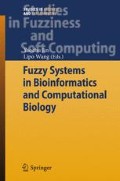Summary
This chapter describes the use of genetic programming to evolve a fuzzy rule base to model gene expression. We describe the problem of genetic regulation in details and offer some reasons as to why many computational methods have difficulties in modeling it. We describe how a fuzzy rule base can be applied to this problem as well as how genetic programming can be used to evolve a fuzzy rule base to extract explanatory rules from microarray data obtained in the real experiments, which give us data sets that have thousands of features, but only a limited number of measurements in time. The algorithm allows for the insertion of prior knowledge, making it possible to find sets of rules that include the relationships between genes that are already known.
Access this chapter
Tax calculation will be finalised at checkout
Purchases are for personal use only
Preview
Unable to display preview. Download preview PDF.
References
Alberts, B., Johnson, A., Lewis, J., et al.: Molecular biology of the cell, 5th edn. Garland Science (2007)
Arnone, M.I., Davidson, E.H.: The hardwiring of development: organization and function of genomic regulatory systems. Development 124, 1851–1864 (1997)
Bansal, M., della Gatta, G., di Bernardo, D.: Inference of gene regulatory networks and compound mode of action from time course gene expression profiles. Bioinformatics 22(7), 815–822 (2006)
Brazma, A., Rukliza, D., Viksna, J.: Reconstruction of gene regulatory networks under the finite state linear model. Genome Informatics 16(2), 225–236 (2005)
Carmona-Saez, P., Chagoyen, M., Rodriguez, R., et al.: Integrated analysis of gene expression by association rules discovery. BMC Bioinformatics 7(54) (2006)
Chen, J.J., Chen, C.-H.: Encyclopedia of biopharmaceutical statistics. In: Microarray Gene Expression, pp. 599–613. Informa Healthcare (2003)
Creighton, C., Hanash, S.: Mining gene expression databases for association rules. Bioinformatics 19(1), 79–86 (2003)
Dasgupta, D., Gomes, J.: Evolving fuzzy classifiers for intrusion detection. In: Proceedings of the 2002 IEEE Workshop on Information Assurance, US Military Academy (2002)
De Jong, H., Gouze, J.L., Hernandez, C., et al.: Qualitative simulation of genetic regulation models using piecewise-linear models. Bulletion of Mathematical Biology 66(2), 301–340 (2004)
Fogel, G.B., Corne, D.W.: Evolutionary computation in bioinformatics. Morgan Kaufmann, San Francisco (2003)
Foteinu, P., Yang, E., Saharidis, G.K., et al.: A mixed-integer optimization framework for the synthesis and analysis of regulatory networks. Journal of Global Optimization (online) (2007)
Freedman, D., Pisani, R., Purves, R.: Statistics, 4th edn. W. W. Norton Publisher (2007)
Freitas, A.A.: A survey of evolutionary algorithms for data mining and knowledge discovery. In: Ghosh, A., Tsutsui, S. (eds.) Advances in Evolutionary Computation, pp. 819–845. Springer, Heidelberg (2003)
Gardner, T.S., Fainth, J.J.: Reverse-engineering transcription control networks. Physics of Life Reviews 2(1), 65–88 (2005)
Gardner, T.S., Faith, J.J.: Reverse-engineering transcription control networks. Physics of Life Reviews 2(65), 88 (2005)
Georgii, E., Richter, L., Ruckert, U., Kramer, S.: Analyzing microarray data using quantitative association rules. Bioinformatics 21(suppl. 21), ii123–ii129 (2005)
Hannah, M.A., Heyer, A.G., Hincha, D.K.: A global survey of gene regulation during cold acclimation in Arabidopis thaliana. PLoS Genet. 1(2), 26–43 (2005)
Heaton, J.T.: Introduction to neural networks with java, 1st edn. Heaton Research, Inc. (2005)
Koza, J.R., Keane, M.A., Streeter, M.J., et al.: Genetic programming iv: Routine human-competitive machine intelligence (genetic programming), 1st edn. Springer, Heidelberg (2005)
Krishnan, A., Giuliani, A., Tomita, M.: Indeterminacy of reverse engineering of gene regulatory networks: The curse of gene elasticity. PLOS One (6), e652 (2007)
Laubenbacher, R., Stigler, B.: A computational algebra approach to the reverse engineering of gene regulatory networks. Journal of Theoretical Biology (229), 523–537 (2004)
Linden, R.: Algoritmos geneticos (genetic algorithms). Brasport (2006)
Linden, R., Bhaya, A.: Evolving fuzzy rules to model gene expression. BioSystems 88(1), 76–91 (2007)
Martinek, D.: A tree representation of fuzzy inference rules. In: Proceedings of 40th Spring International Conference MOSIS 2006, Prerov, CZ, p. 6 (2006)
Mistra, J., Schmitt, W., et al.: Iterative explorations of microarray gene expression patterns in a reduced dimensional space. Genome Research, 1112–1120 (2002)
Nuber, U. (ed.): DNA microarrays, 1st edn. Advanced Methods Series. Taylor and Francis, Inc., Abington (2005)
Pal, R., Datta, A., Bittner, M.L., Dougherty, E.: Intervention in context-sensitive probabilistic boolean networks. Bioinformatics 21(7), 1211–1218 (2005)
Ross, T.H.: Fuzzy logic with engineering applications. Wiley, Chichester (2004)
Schlitt, T., Brazma, A.: Current approaches to gene regulatory network modelling. BMC Bioinformatics 8(suppl. 6), 9 (2007)
Tegner, J., Yeung, M.K.S., Hasty, J., Collins, J.J.: Reverse engineering gene networks: Integrating genetic perturbations with dynamical modeling. PNAS 100(10), 5944–5949 (2003)
Van Someren, E.P., Wessels, L.F.A., Reinders, M.J.T.: Linear modeling of genetic networks from experimental data. In: Proceedings of the Eighth International Conference on Intelligent Systems for Molecular Biology, pp. 355–366. AAAI Press, Menlo Park (2000)
Wahde, M., Hertz, J.: Coarse-grained reverse engineering of genetic regulatory networks. BioSystems 55(1), 129–136 (2000)
Wang, L., Mendel, J.M.: Generating fuzzy rules by learning from examples. IEEE Transactions on Systems, Man and Cybernetics 22(6), 1414–1427 (1992)
Wang, Y., Tetko, I.V., Hall, M.V., et al.: Gene selection from microarray data for cancer classification–a machine learning approach. Computational Biology and Chemistry 29(1), 37–46 (2005)
Wehrli, A.V., Grzegorczyk, M., Husmeier, D.: Comparative evaluation of reverse engineering gene regulatory networks with relevance networks, graphical gaussian models and bayesian networks. Bioinformatics 22(20), 2523–2531 (2006)
Yang, Z.R., Thomson, R., et al.: Searching for discrimination rules in protease proteolytic cleavage activity using genetic programming with a min-max scoring function. BioSystems 72, 159–176 (2003)
Zhu, X., Gerstein, M., Snyder, M.: Getting connected: analysis and principles of biological networks. Genes and Dev. 21, 1010–1024 (2007)
Author information
Authors and Affiliations
Editor information
Editors and Affiliations
Rights and permissions
Copyright information
© 2009 Springer-Verlag Berlin Heidelberg
About this chapter
Cite this chapter
Linden, R., Bhaya, A. (2009). Evolving a Fuzzy Rulebase to Model Gene Expression. In: Jin, Y., Wang, L. (eds) Fuzzy Systems in Bioinformatics and Computational Biology. Studies in Fuzziness and Soft Computing, vol 242. Springer, Berlin, Heidelberg. https://doi.org/10.1007/978-3-540-89968-6_10
Download citation
DOI: https://doi.org/10.1007/978-3-540-89968-6_10
Publisher Name: Springer, Berlin, Heidelberg
Print ISBN: 978-3-540-89967-9
Online ISBN: 978-3-540-89968-6
eBook Packages: EngineeringEngineering (R0)

